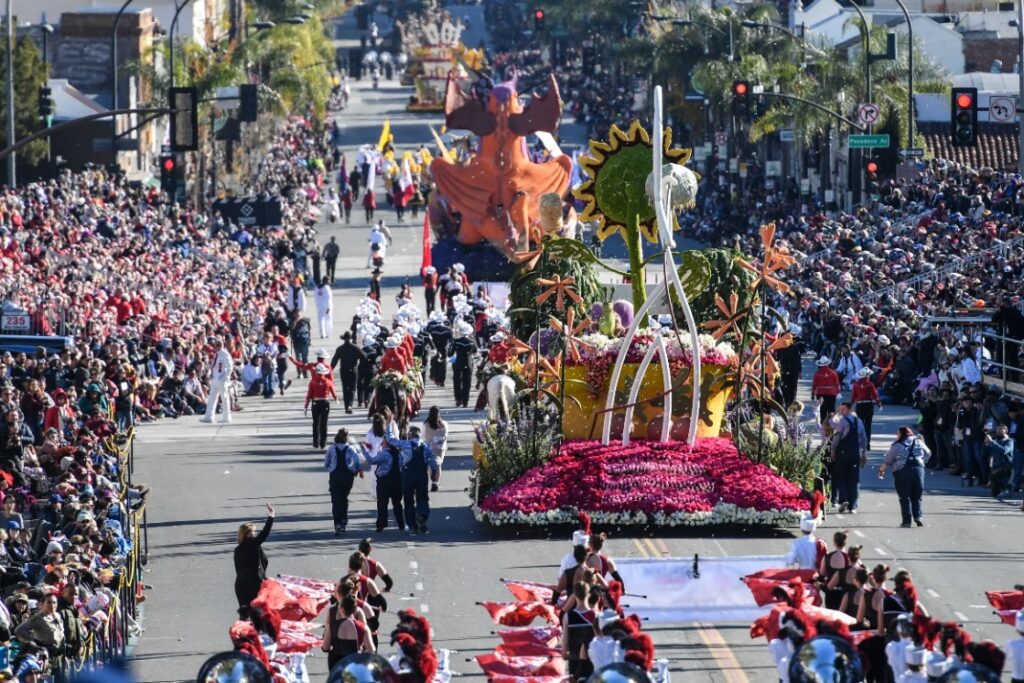In 1874, Dr. Daniel M. Berry of Indiana brought many of his patients to the area around the foothills of Los Angeles. The mild temperature offered a better climate for most of the patients who suffered from tuberculosis. Berry formed the Indiana Colony which later became Pasadena.
Pasadena was incorporated in 1886, becoming the second city after Los Angeles to do so in what is now Los Angeles County. One of the main objectives of incorporation was to make it legally possible to rid the city of its numerous saloons and alcohol sales. In February 1887, an ordinance was passed that banned liquor sales in Pasadena. The very unpopular ordinance was repealed in 1892.
Though the Minnesota Chippewa Native Americans were not indigenous to the area, the word Pasadena, translated from the Chippewa language means “of the valley.” Loosely interpreted now to mean “Crown of the Valley” the phrase is on the official seal of the city.
Pasadena became a quick stop for the Atchison, Topeka, and Santa Fe Railroad’s transcontinental line in 1887. The route to Pasadena originated as a second railroad line out of Los Angeles. In 1925, the passenger station in Pasadena was opened.
Originally, the Second Line (District) served manufacturing and agricultural businesses throughout the entire San Gabriel Valley. Unfortunately, the longer steam trains had difficulty climbing the 2.2% grade at Arroyo Seco, between Pasadena and Los Angeles. Additional locomotives were often necessary. A third line opened in 1888, taking on the longer freight trains, relegating the Second District to provide mostly passenger service to travelers between the coasts.
At its peak in the late 1950s, 26 passenger trains went through Pasadena every day. In order to avoid the media in Los Angeles, celebrities often chose to use Pasadena as their main train station, bringing to it an atmosphere of the glamour days of Hollywood.
Passenger trains continued to roll through Pasadena until 1994, when the Metro bought the track right-of-way for a new light rail corridor known today as the Gold Line. Metro dug under Colorado Blvd. so as not to interfere with traffic and the New Year’s Rose Parade. On January 14, 1994, Amtrak’s Southwest Chief made its final stop at the Santa Fe depot on Raymond Avenue. Still standing, the station is now an upscale café.
Another lesser-known rail line but just as valuable to the area was The Pasadena Short Line operated by the Pacific Electric Railway running from 1902 until 1951 between Downtown Los Angeles and Downtown Pasadena.
The Short Line route began as a horsecar line in 1894. By1902 service ran between the Raymond Hotel in Pasadena and the junction with the Alhambra ATSF Line at Valley Blvd. Rail service along the twelve-mile line reached almost eight thousand commuters and shoppers every day. Service was replaced by buses after September 30, 1951
The history of Pasadena’s rail service also includes a tourist attraction incorporated as the Pasadena & Mt. Wilson Railroad Co. and later becoming The Echo Mountain Incline Railway which opened in 1893. The incline railway rose 1900 feet. At the top was a mountain chalet resort and the Alpine Tavern. The seven-mile-long electric traction line is locally referred to as the Mt. Lowe Railroad. After many natural disasters, fires and floods, the line stopped service in 1938.
Pasadena’s Orange Grove Blvd. just south of Colorado Blvd. has long been known as “Millionaire’s Row” for the lavish mansions that once lined the street. There are two mansions still in use today.

Chewing gum magnate William Wrigley’s mansion c. 1950, now the headquarters of the Pasadena Tournament of Roses Association.
The Tournament of Roses event began as a promotional effort by Pasadena’s Valley Hunt Club. In the winter of 1890, club members developed a plan to show off the mild southern California climate to those suffering on the east coast. They invited their former east coast neighbors to a winter holiday, where they could watch games such as chariot races, jousting, foot races, polo, and tug-of-war under the warm California sun. The availability of plenty of fresh flowers, even in the winter, prompted the club to add another way to show off Pasadena’s charm: a parade to precede the competitions where entrants decorated their carriages with hundreds of blooms. From that event came The Tournament of Roses Parade.
The first parades drew a few thousand viewers along the 5.5-mile route down Colorado Blvd. By 1895, the Tournament of Roses Association was formed to take charge of the festival, which had grown too large for the Valley Hunt Club to handle. Today, about 1,000,000 people come to Pasadena to watch the Tournament of Roses Parade.
The Rose Parade’s elaborate floats now feature high-tech computerized animation and exotic natural materials from around the world. Most of the floats are built by professional float building companies, augmented by volunteers, and take nearly a year to construct. Close to 1000 volunteers provide more than 80,000 hours of volunteer effort.
Floats must be completely covered with flowers, greenery, or other natural material, with an average float requiring up to 100,000 blossoms. It is estimated that more than one-half million roses in vials are used in each parade. The average cost of a finished float is between $75,000 and $250,000 depending on the size and mechanics of the float.
The first Tournament of Roses football game, which was the first post-season football game in the nation, was staged at Pasadena’s Tournament Park on January 1, 1902. The game matched the West Coast’s Stanford “Indians” against Midwestern’s Michigan “Wolverines.” Michigan routed Stanford, 49-0. Because the west coast team did so poorly, the next Rose Bowl game wasn’t until 1916 when the game was permanently reinstated as part of the Tournament’s traditions.














